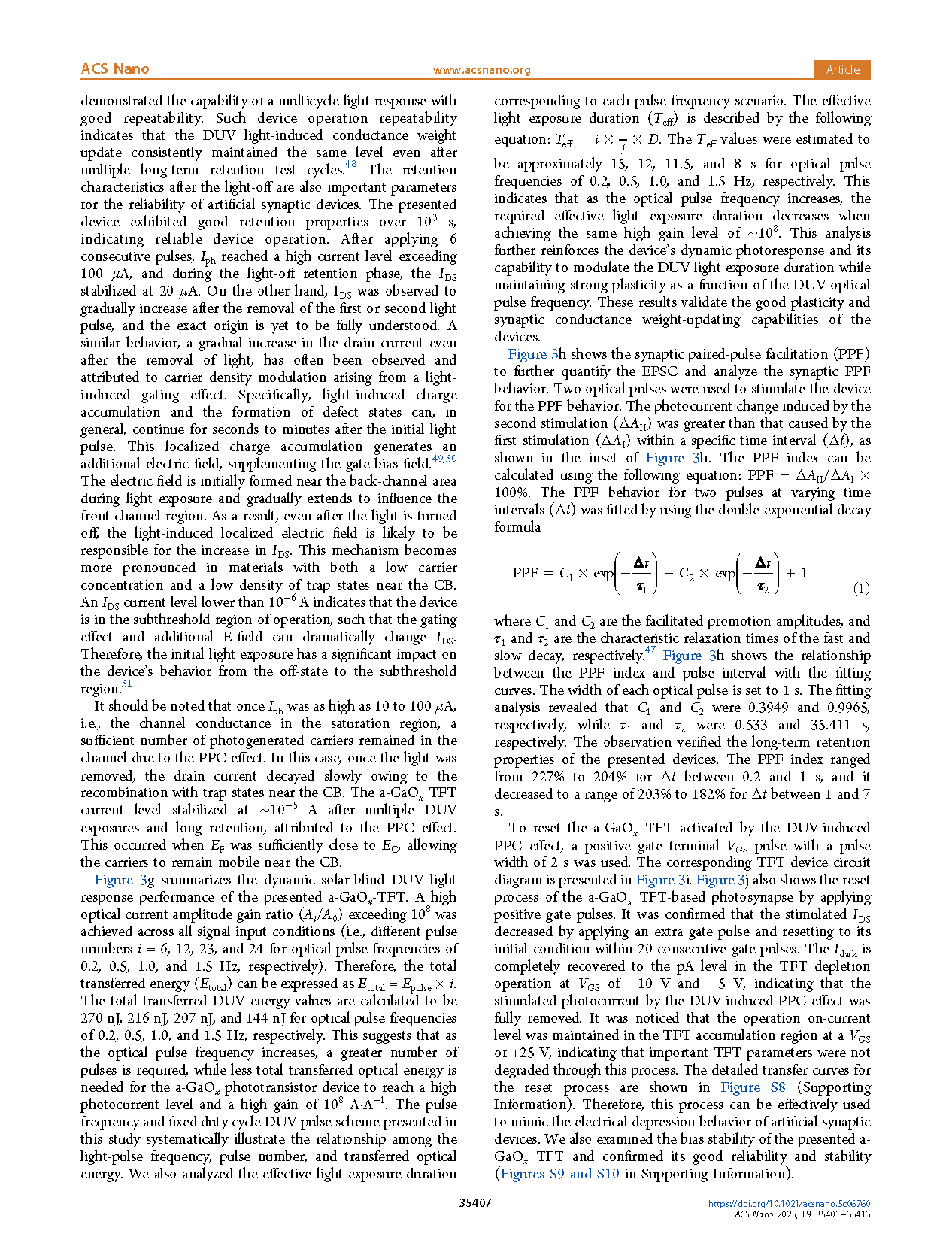

【International Papers】Artificial Solar-Blind Optosynapses Using Amorphous Gallium Oxide Phototransistors for Optical In-Sensor Neuromorphic Applications
日期:2025-11-03阅读:143
Researchers from the University of California San Diego have published a dissertation titled "Artificial Solar-Blind Optosynapses Using Amorphous Gallium Oxide Phototransistors for Optical In-Sensor Neuromorphic Applications" in ACS Nano.
Background
Energy-efficient neuromorphic computing is a transformative paradigm in computational systems inspired by the structure, function, and efficiency of the human brain. It aims to mimic neural architectures to solve complex tasks such as pattern recognition, decision-making, and real-time learning, offering a new path toward highly energy-efficient and parallel computation systems for artificial intelligence (AI), healthcare, and autonomous systems. Artificial synaptic devices, which enable communication between neurons and implement learning rules such as spike-timing-dependent plasticity (STDP), are key hardware components for neuromorphic computing. Nonvolatile memory devices, such as memristors, are well-known elements that emulate synaptic plasticity by adjusting their resistance based on the history of applied voltage or current. In particular, photosynaptic transistors, which integrate the functions of a spectral-selective phototransistor and synapse, have emerged as promising advanced components. These devices enable the direct processing of optical inputs, making them highly attractive for versatile applications in neuromorphic computing, optical communication, and adaptive memory systems.
Abstract
Optoelectronic neuromorphic devices, which mimic the functionalities of the human eye and brain neural systems, have attracted significant interest for enabling highly energy-efficient computing systems for next-generation artificial intelligence applications. However, several key challenges persist, including a limited dynamic range for light-induced synaptic weights, low optical photogain, lack of spectral selectivity, and incompatibility with heterogeneous integration. Addressing these issues is essential for unlocking the full potential of optosynaptic devices in advanced AI systems. In this work, we develop artificial solar-blind optoelectronic synaptic devices exhibiting high pattern recognition rates (>92%) in neural network training using ultrawide-bandgap amorphous gallium oxide (a-GaOx) thin-film transistors (TFTs). The device functions through deep ultraviolet (DUV) optically induced potentiation and gate-terminal electrical depression processes, exhibiting excellent plasticity and a wide conductance weight update range. This performance is attributed to its superior TFT switching characteristics, strong DUV photoresponse with a dynamic gain exceeding 108, and UV-triggered persistent photoconductivity (PPC) lasting over 1000 s. Moreover, the device can be fabricated at a low temperature of 450 °C, ensuring compatibility with the complementary metal-oxide–semiconductor (CMOS) back-end-of-line (BEOL) process.
Conclusion
In this work, we developed a solar-blind photosynaptic TFT using an ultrawide-bandgap n-type amorphous a-GaOx channel for optical in-sensor neuromorphic applications. The device exhibited a strong DUV photoresponse with a high detectivity of >1017 Jones and a high dynamic photocurrent gain of >108, which were attributed to the high-performance a-GaOx-TFTs exhibiting a high electron mobility of 20 cm2V−1s−1 and a large on/off current ratio of ∼108. The TFT device operated as optosynapses based on solar-blind UV pulse-stimulated potentiation and electrically induced depression by gate-terminal pulse input, which exhibited wide plasticity and conductance change capability with good repeatability and long-term retention characteristics of >103 s. This demonstrated a high pattern recognition accuracy of >92% for both 8 × 8 and 28 × 28 pixel images. The present developments not only significantly contribute to advancing ultrawide amorphous oxide semiconductor device technology but also offer new prosperity for next-generation novel AI applications using oxide thin-film transistor technology.

Figure 1. (a) UV−vis optical absorption coefficient (α) spectra for the a-GaOx thin films. The inset shows a photograph of the a-GaOx thin films, indicating that the film is optically transparent to visible light. Bandgap extraction of (b) the (αhν)1/2−hν plot for the indirect bandgap and (c) (αhν)2 −hν plot for the direct bandgap. (d) GIXRD pattern and (e) near-VBM XPS spectrum for the a-GaOx film. The corresponding electronic band structure with energies EC, EF, and EV is also provided as an inset of (e). (f) Transfer and (g) output characteristics of the inverted-staggered a-GaOx-TFTs under dark conditions. (h) Schematics of the electronic and defect structures deduced from optical analysis and TCAD-TFT simulation analysis for a-GaOx.

Figure 2. (a) Schematic of a-GaOx phototransistor DUV photoresponse measurements and recovery process. (b) Transfer curves (IDS−VGS) at VDS = 20 V in the dark and under DUV light illumination (265 nm) for a-GaOx-TFTs. The inset shows a schematic diagram of the measurement setup. (c) Photocurrent as a function of VGS, Iph−VGS curves. The corresponding (d) R and D*, (e) EQE and PDCR values as a function of VGS. (f) The PPC elimination process by gate-terminal pulsed modulation (positive VGS of +20 V with 2s pulse width) for aGaOx-TFTs. The inset of (f) shows the DUV-induced PPC effect from the transfer characteristics in the linear scale, where the red and blue lines represent the UV-light on and off states, respectively. (g) Summary of a-GaOx DUV phototransistor performance in terms of detectivity and PDCR as a function of device mobility.

Figure 3. (a−d) Solar-blind DUV photoresponse in linear and logarithmic scales at different light-pulse frequencies of 0.2, 0.5, 1.0, and 1.5 Hz for a-GaOx-TFTs. The inset shows the pulse scheme of the measurement. (e) Retention characteristics for different numbers of DUV-light-pulse inputs (1−6 pulses) with a 0.2 Hz square-wave. For comparison, the dark current is shown as background noise. (f) Number of DUV pulse input dependency of the photoresponse in the linear (top) and logarithmic (bottom) scales. (g) Dynamic photocurrent amplitude gain ratio over 108 and total transferred DUV optical energy as a function of light-pulse frequency. (h) PPF index as a function of the interval time (Δt). The circles and lines represent the experimental values and fitting curves, respectively. The inset presents ΔIph stimulated by two consecutive optical pulses (pulse duration is 1 s, and Δt is 2 s). (i) Device circuit diagram for the PPC reset process by positive gate-terminal pulses and (j) variation in IDS by positive gate-terminal pulse inputs to reset the stimulated state to the initial state. IDS as a function of time was recorded at different VGS values of 25, −5, and −10 V. The inset shows the positive gate pulse schemes.

Figure 4. (a) Time-resolved photoconductivity decay spectrum for a-GaOx thin films. Schematic illustration of the variations in the energy band diagrams of a-GaOx TFTs during optosynaptic operation. (b) Negative gate bias under dark conditions, (c) under DUV light stimulation, (d) retention process by the PPC effect, and (e) reset process by positive gate-terminal pulses under dark conditions.

Figure 5. (a) Conductance weight update changes for the solar-blind UV pulse-stimulated potentiation and electrical gate-terminal pulseinduced depression artificial optosynapses using the a-GaOx-TFT. (b) Three-layer neural network for pattern recognition simulation task, and (c) emulated biological synapse responses with presynapse, postsynapse, and neuromodulator. Probability distribution ΔG vs G used in the neural networking training task for (d) potentiation and (e) depression. (f) Pattern recognition accuracy of 8 × 8 and 28 × 28 pixel images. (g) Confusion matrix for the neural network. All the correct classifications are located on the matrix diagonals.
DOI:
doi.org/10.1021/acsnano.5c06760















